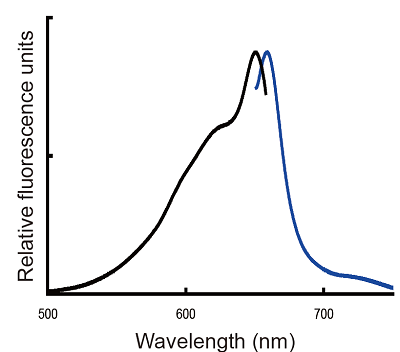General Information
Allophycocyanin Labeling Kit - NH2 is primarily used for the preparation of allophycocyanin-labeled antibody for immunostaining and cellular proteins for tracing. NH2-Reactive Allophycocyanin, a component of this kit, has succinimidyl ester groups, and can easily make a covalent bond with amino groups of IgG or other proteins without any activation process. Filtration Tube included in this kit is used for removing small molecules in the sample protein such as Tris buffer and amine compounds that interfere with the assay or labeling reaction. The maximum excitation and emission wavelengths of the allophycocyanin-labeled proteins are 650 nm and 660 nm, respectively. This kit contains all of the necessary reagents for labeling, including the storage buffer for conjugates.
Kit Contents
| NH2-Reactive Allophycocyanin | 3 tubes |
| WS Buffer | 4 ml x 1 |
| Reaction Buffer | 200 μl x 1 |
| Filtration Tube | 3 tubes |
Capacity
Three samples labeling
- Sample requirement: Molecular weight > 50,000; amount: 50-200 μg
Storage Condition
Store at 0-5℃. This kit is stable for 1 year at 0-5°C before opening.
|
Caution After a NH2-Reactive Allophycocyanin is taken out from the seal bag, keep the unused NH2-Reactive Allophycocyanin(s) in the bag, seal tightly and store at -20°C. |
Required Equip-
- 10 μl, 200 μl adjustable pipettes
- Incubator (37°C)
- Microcentrifuge
- Microtubes
Precaution
- If the target protein solution contains other proteins with molecular weight larger than 10,000, such as serum albumin or gelatin, purify the protein solution, and use the purified target proteins for allophycocyanin labeling, because it might interfere the labeling reaction.
- If the protein solution contains small insoluble materials, centrifuge the solution, and use the supernatant for the labeling.
- The droplets which induced from the dry inhibitor of membrane, are occasionally found inside Filtration Tube while storing the kit at 0-5oC or after returning to room temperature. This phenomenon does not affect the performance.
- This kit includes microtubes containing solutions. Since there is a possibility that the droplets might attach to the inside walls or caps, please shake them down prior to open.

|
|
Maximum excitation wavelength: 650 nm |
General Protocol
- Labeling for IgG -
-
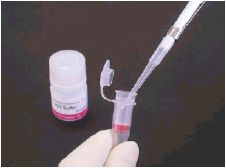
Step 1.
Add 100 μl WS Buffer and the sample solution containing 50-200 μg IgGa) to a Filtration Tube.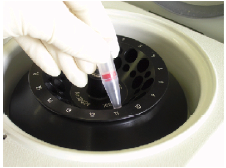
Step 2.
Pipette to mix and centrifuge at 8,000 x g for 10 min.b)
-
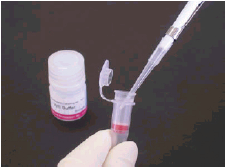
Step 3.
Add 100 μl WS Buffer to a Filtration Tube again.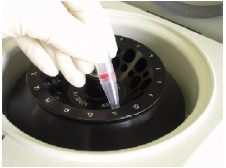
Step 4.
Centrifuge at 8,000 x g for 10 min again.b)
-
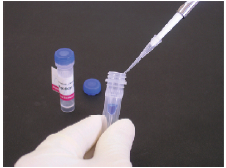
Step 5.
Add 10 μl Reaction Buffer to NH2-Reactive Allophycocyanin, and dissolve with pipetting.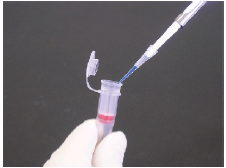
Step 6.
Add NH2-Reactive Allophyco-cyanin solution to the IgG concentrated on the Filtration Tube.
-
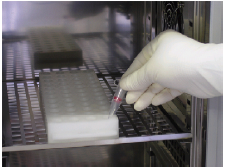
Step 7.
Incubate the tube at 37°C for 2h after pipetting to mix.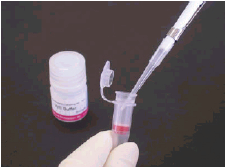
Step 8.
Add 190 μl WS Buffer, and pipette about 10 times to recover the conjugate.d) Transfer the solution to a microtube (not included in this kit), and store at 0-5°C.e)
a) The volume of IgG solution should be less than 100 μl. If the IgG concentration is lower than 0.5 mg/ml, repeat Steps 1. and 2. until the total IgG accumulation becomes 50 - 200 μg.
b) If solution still remains on the membrane after the centrifugation, spin for another 5 min.
c) NH2-Reactive Allophycocyanin can be hydrolyzed by water. Proceed to Step 6. immediately after the preparation of the NH2-Reactive Allophycocyanin solution.
d) One to two allophycocyanin should be introduced into one IgG molecule. Unconjugated allophycocyanin remained in the solution might cause background increase with immunoassay. If purification is necessary, purify the conjugate using a gel permeation column or an affinity column for IgG.
e) We recommend using WS Buffer to recover the conjugate. However, you can use an appropriate buffer for the downstream experiments.
Q & A
Can I use this kit to label antibody which is commercially available?
Yes. However, if antibody solution contains other proteins such as serum albumin or gelatin, labeling reaction might be interfered by that protein.Purification of the antibody solution with affinity chromatography is necessary prior to use this kit. Contact us for the purification procedure, if you need.
What is the minimum amount of protein that can be labeled using this kit?
We recommend using 50 μg as a minimum amount. Though 10 μg protein can be labeled using this kit, the background might be increased.
Does NH2-Reactive Allophycocyanin form an oligomer during the labeling reaction?
No. Since all amino groups of NH2-Reactive Allophycocyanin are blocked, no oligomerization is occurred.
How long is the allophycocyanin labeled protein stable?
The stability depends on the protein itself. For longer storage, add equal volume of glycerol to the sample solution and store at -20℃.
Can I use the allophycocyanin conjugated protein that is precipitated in storage?
Yes. The precipitated protein should be removed by centrifugation at 10,000 x g for 10 min, and use the supernatant.
Is there any notice for treatment of living cells with the allophycocyanin conjugated protein?
We recommend using PBS including 2-10% FBS for preparation of cell suspension to maintain the best cell condition.
Does recovery buffer (WS Buffer) have harmful effect to living cells?
No. WS Buffer contains stabilizing agent (surfactant) that is controlled of its concentration without cytotoxicity.
If you are concerned about the additive in WS Buffer, you can use your own buffer currently used instead of WS Buffer.
Frequently Asked Questions / Reference
LK21: Allophycocyanin Labeling Kit - NH2
Revised Nov., 28, 2023


 Hidden sections will not be printed.
Hidden sections will not be printed.